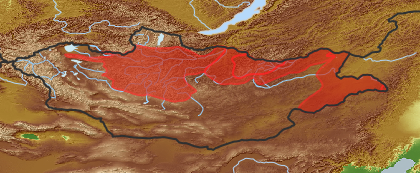| Class: | angiosperms |
| Order: | Malvales |
| Family: | Thymelaeaceae |
| Editor | S. Rilke, July 2009 |
| Name acc. to: | APGII |
| Herbar: | list records   |
| Description: | Calyx tubular, campanulate, or infundibuliform, usually corollalike, 4- or 5(or 6)-merous. |
| Link to Flora of China: | http://www.efloras.org/florataxon.aspx?flora_id=2&taxon_id=10894 |
| open map in a new window |  |
| genus: 2 |
| species: 2 |
| Habit (i)general appearance of a plant | |
| Growth form: (i)Herb, shrub, tree or climber. | herb (i)Herbaceous, erect plant, up to 2m high, mostly with a leafy shoot; if perennial, shoots die to the ground each season, shoots are not woody
example: Artemisia pectinata 
|
| Parasite status: (i)Is the plant a half- or full parasite? | no parasite/saprophyte (i)Plant fully autonomous, leaves with chlorophyll
example: Most plants, Ranunculus
|
| Water or terrestrial plant: (i)Where do the plants grow? | terrestrial (i)Plant grows on dry land
example: Orostachys spinosa
|
| Leaf (i)expanded, usually photosynthetic organ of a plant (including phylloclades) | |
| Leaf development: (i)Structure and development of leaves. | with green leaves (i)Plant with green leaves
|
| Leaf arrangement: (i)Arrangement of leaves at the stem. | alternate (i)One leaf per node; distiche: arranged in two vertical rows, equitant
example: Phragmites  
|
| Simple or divided leaves: (i)Are the leaves simple or completely divided in several parts? Blade of the leaf entire or (more or less) deeply dissected. Attention: There are various appearances of the leaf margin (from entire to toothed and lobed). Here, we ignore this and ask only for dissections that separate the leaf for more than one third of its length or width, whatever is smaller. Sometimes, it is difficult to tell apart compound leaves from a shoot system with simple leaves: look for stipulae and/or axillary buds at the ground of the leaves: if only some possess these structures, the others are most likely leaflets of a compound leaf. | simple (i)Non-divided leaf, but margin may be incised nearly to the ground 
|
| Leaf margin: (i)Structure of leaf margin (or that of a leaflet in case of compound leaves). Attention: Here we ask for the leaf margin, defined as all those dissections that separate the leaf for less than one third of its length or width, whatever is smaller. To be worked out: how to handle margin of pinnate leaves? | entire (i)Plain margin, not toothed
example: Iris 
|
| Stipule: (i)Leaflets at the base of the petiole, these are smaller and of different shape. | none (i)Without stipules
example: Euphorbia, Ericaceae s.l.
|
| Leaf veination: (i)Arrangement of the main veins of a leaf. | pinnate (i)One main vein, several side veins, sometimes inconspicuous
example: Cicerbita   
|
| Flower (i)reproductive portion of the plant, consisting of sepals, petals, stamens, and pistils | |
| Flower appearance and pollination: (i)General appearance of the flower. | attractive, animal-pollinated (i)attractive and coloured flowers, mostly large, attracting surely animals
example: Trollius, Rosa, Chamaerhodos
|
| Perianth arrangement: (i)Attention: in some plants, flowers may be dimorphic in different ways (dioecious or gynodioecious). If flowers vary, record the characters of the most showy flowers. | simple, similar (i)Only one type of perianth leaves (tepals)
example: Tulipa 
|
| Flower symmetry: (i)Symmetry of the perianth leaves. Attention: to assess this character, look on sepals, petals and stamens, but neglect carpels and ovary. | radiary, regular (actinomorphic) (i)More than two axis of symmetry
example: Saxifraga: 5; Iris: 3 
|
| Flower form: (i)common forms of flowers ? Veronica | tubular to funnel-shaped (i)Petals form a tube, are often partially united to a cylindrical corolla, often surrounded by a calyx 
|
| Sepal fusion: (i)To which degree are the sepal leaves connected? Attention, this character applies only for flowers separated in sepals and petals, thus excluding most monocots. Be aware of the bracts (involucral leaves) of Asteraceae flowerheads, do not qualify these as sepals! | fused (i)Leaves united, only tips are free
example: Fabaceae, Silene  
|
| Spur: (i)A hollow, slender, sac-like appendage of the perianth leaves, storing nectar. | no spur (i)Flower without appendage
example: Peganum
|
| Stamen fusion: (i)To which degree are the stamens fused? Attention: Whereas the pollen sacs itself are often free., their stalks (filaments) may be fused. Here, we count them as fused if they are together over at least one thirth of their length. | fused with a corolla (calyx in Thymelaeaceae) (i)Stamens with perianth leaves at least one third of the length of the filament
example: Orobanche, Salvia, Stellera
|
| Ovary position: (i)For entirely or partly fused carpels, describe their position in relation to the insertion point of perianth leaves (best done by doing a longitudinal section of a flower). | superior (hypogynous) (i)Base of carpels attached above insertion point of perianth leaves, carpels free or fused
example: Delphinium, Anemone  
|
| Sex: (i)Distribution of male and female organs among flowers, only most commonly cases. | bisexual, hermaphrodite (i)All or nearly all flowers of a plant with male and female parts
example: Haplophyllum, Chenopodium
|
| Inflorescence (i)flowering part of a plant, describes the arrangement of the flowers on the flowering axis | |
| Inflorescence: (i)Structure of the inflorescence. | Flowers in inflorescence (i)No solitary flowers
|
| Appearance: (i)Outer look of the inflorescence. | terminal (i)Inflorescence is the highest point of the plant and may consist of a single flower only
example: Cypripedium, Rhaponticum, Ligularia sibirica, Echinops
|
| Root / shoot below ground (i)plant part below ground (in most cases), including below ground shoots, without leaves | |
| Root type: (i)Organisation of the roots. | allorhizous (i)Plant with a conspicuous tap root, one larger tap root with side roots
example: Dicotyledonae  inherited by order Malvales: allorhizous inherited by order Malvales: allorhizous
|